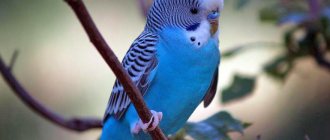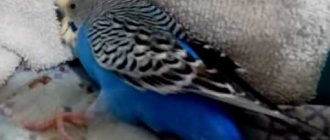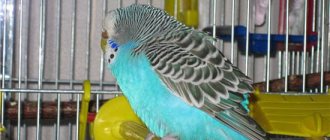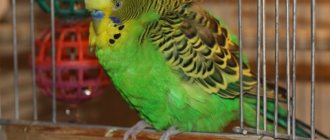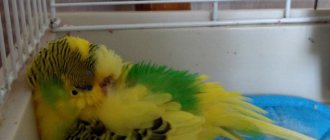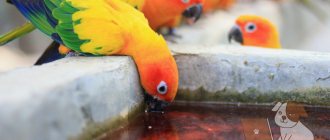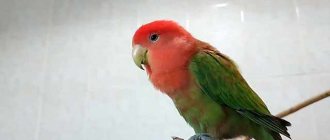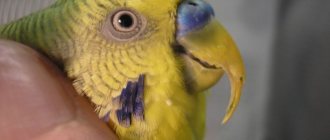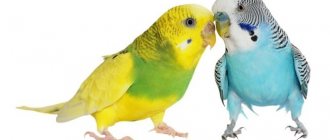A lot has been written about diseases of the paws of budgies, but each specific case must be dealt with separately. Bird owners are often left without practical help when it comes to treatment. Experiments with various drugs and methods of healing only aggravate the pathological process. The pelvic limbs of parrots bear the main load, and sometimes they cannot stand it. Let's talk about what kind of troubles happen to birds' feet and how to help your pet cope with the disease.
Problems with a parrot's legs
If the parrot is in good health and has healthy legs, it walks freely and jumps from perch to perch. While eating, it stands on one paw, and the other one holds a piece of fruit and pecks it. When he goes to bed or dozes, he tucks one limb under his abdomen and lets it rest.
Changed behavior may indicate that the parrot has pain in one leg:
- the bird often picks it up and fiddles with its beak;
- stops walking, tries to crawl;
- limps, cannot walk;
- trembles constantly;
- itches against surrounding objects, cage bars;
- falls from the perch during sleep and wakefulness.
Judging by the appearance of the pelvic limbs, it becomes clear that not everything is all right with the parrot:
- the skin takes on a strange shade and feels cold or hot to the touch;
- blood or ichor oozes from the leg;
- the epithelium peels off and grows, bumps appear;
- ulcers appear on the fingers;
- the joints swell, the paws differ noticeably in thickness from each other.
Next, we will consider several situations that cause the owner to worry about the pet’s paws.
Mobility is the enemy of the parrot
This little bird often suffers due to its hyperactivity and curiosity. Living spaces filled with furniture are especially dangerous for birds. The bird moves freely around the room at its natural speed, but on its way it may encounter an obstacle that will cause injury.
Other pets can also harm the feathered creature. To prevent the parrot from falling into the paws of a cat or dog, you should not leave it unattended for a long time. It is not recommended to open the cage in the presence of other pets. When leaving home, check that the latch on the cage is firmly closed and that the cat cannot get into the bird’s home.
Paws refused
Paralysis of the pelvic limbs occurs when there are disturbances in the functioning of the nervous system. If a parrot's leg fails, it looks pitiful: it tries to get up, but falls to the side and can only crawl, helping itself with its beak.
The parrot's legs gave out
This condition is caused by stress, severe bruises, and some illnesses. As an example, a concussion after a bird hits the glass. At first, the legs do not stop functioning, other symptoms appear:
- lack of coordination of movements;
- convulsions;
- lack of concentration;
- loss of consciousness.
On a note! Also, the limbs do not work in case of severe poisoning. If a parrot is frequently fed vitamin supplements, the substances accumulate in the body, causing muscle atrophy. It is difficult to neutralize intoxication, so you should not overuse fertilizing.
Fractures due to osteoporosis
Poor nutrition and calcium deficiency can cause fragility of bone tissue in birds. In this case, not only the limbs suffer, but also the beak, chest, and claws. The thyroid gland enlarges, separation and deformation of the beak and claws are observed. Lovebirds often suffer from this disease: birds of this species have a low calcium content in the body.
If your pet experiences frequent fractures, this indicates the development of osteoporosis. What to do if this is not the first time your pet has broken a limb? It is necessary to carry out all the necessary manipulations to disinfect and fix the damaged area.
In the case of repeated fractures, a full examination of the pet is carried out in a clinic. A veterinarian or ornithologist will immediately suspect osteoporosis and calcium metabolism disorders.
If the parrot breaks its leg again, the ornithologist will suggest a special diet and the use of vitamin supplements with calcium, which should be available to the pet around the clock. Once the bird’s diet is enriched with all the necessary vitamins and microelements, recovery will occur quickly.
Cold paws
If in its normal state the skin on the parrot’s paws is pinkish and slightly warm, then a bluish tint may signal that the bird is frozen. This is possible at the beginning of autumn, when the heating is not yet working. Ventilating the room and bathing the bird also causes a decrease in temperature. A parrot can also have cold feet due to stagnation of blood due to lack of movement.
Cold paws
First of all, you need to warm your ward: turn on the ultraviolet lamp next to the cage, pick up the pet or simply let it fly. If this is a temporary phenomenon, the temperature will soon return to normal.
You should start to worry if additional symptoms appear: loose stools, refusal to eat, general weakness, “taciturnity.” Poisoning or a viral disease may be suspected. You should seek help from a veterinarian.
Dropsy
Incorrectly selected crossbars for the paws of a pet parrot can lead to the formation of dropsy on the skin. At the same time, the parrot’s leg constantly hurts, and the owner does not know what to do. The main symptom is that the bird tries not to lean on the limb.
In this case, it is also necessary to consult a veterinarian who will prescribe anti-inflammatory drugs. Taking vitamin complexes will also help, which will allow the skin to heal and renew itself faster. After consulting with an ornithologist, it is necessary to select a crossbar suitable for the size of the bird’s paws so that inflammation does not occur again.
Hot paws
The legs overheat if the pet moves actively. A parrot's paws become hot if it intends to attack an opponent, peck its owner, or grab a tasty morsel. It depends on your temperament. In sluggish, boring individuals, the limbs are almost never hot.
You can talk about pathology if certain areas of the paws are much warmer. Typically, with joint diseases, the affected areas are hot, while the remaining areas are at normal or slightly lower temperatures. When a bird feels bad, it sits lower on the crossbar and spreads its legs wide.
This is interesting! A bird’s body temperature is 2–4 degrees higher than a human’s, so out of habit it seems to us that the parrot has hyperthermia. An electronic thermometer will help you cope with panic: you need to record several indicators during the day to make sure the bird is healthy.
The bird presses its paw
When a parrot tucks one leg, it is probably resting. It is difficult for birds to constantly move, stand and sit with support on two limbs, so they relieve them one by one from the load. But this can only be said with confidence about those birds that always behave this way.
Changed habits may indicate that the parrot is experiencing discomfort. If he is used to sleeping sitting on both legs, but now pulls one of them under himself, he may be in pain. Sometimes discomfort is caused by improperly sized perches. Remove the thin plastic bars from the cage and secure natural, untreated branches in it. Inspect and feel the limb being protected. If you notice a wound, swelling, growths or ulcers, take your bird to the veterinarian.
Growths, peeling
Every parrot develops tumors on its legs at least once in its life. Ugly growths are a consequence of processes in the skin caused by the activity of parasites. A common infectious disease among birds is knemidocoptic mange, a scabies mite.
Microorganisms colonize unfeathered areas of the skin, make passages in them, feed on particles of the epithelium and secrete their waste products inside. Moving in the skin, the scabies mite causes unbearable itching; the bird constantly itches and pecks at the metatarsus. The skin becomes loose, peels, and the surface layer crumbles.
Growths on the paws
Treatment for scabies is simple, but long-term. The affected paws of the parrot are treated with aversectin ointment according to a special scheme. Unfortunately, recovery does not guarantee that the parrot will not contract the disease again in the future. Ticks are carried on tree branches and used equipment. You can become infected from other birds if quarantine is not observed.
On a note! Growths on the paws appear not only with knemidocoptosis. Excess calcium causes calcareous deposits on the metatarsals in the form of plates. You can cope with this problem by adjusting your diet.
How to help
To make an accurate diagnosis, you need to consult a veterinarian. He will conduct a full examination, if necessary, take material for testing and prescribe treatment.
First aid can be provided at home. If the parrot is injured, you need to limit its movement and fix the injured limb in a stationary position. Wounds and open fractures are treated with an antiseptic to prevent infection. For many diseases, birds require a special diet. Thus, in case of gout, food of animal origin is excluded from the diet, and in case of frequent fractures, additional mineral supplements are introduced.
It is impossible to treat parasitic infestations and inflammatory processes in the skin and joints without the use of special drugs: antiparasitic agents and antibiotics. For congenital pathologies and gangrene, surgical intervention is required.
Diseases and injuries of paws - how to treat
Birds can repeatedly injure their fragile limbs throughout their lives, as they bear increased stress. If one foot does not work, the second one must take on double duty. In addition to problems in everyday life, parrots have congenital pathologies: lack of fingers, congenital dislocations, calcium deficiency.
Causes of foot diseases in parrots:
- lack of movement;
- poor living conditions;
- poor nutrition;
- poor quality equipment;
- hereditary factors.
Not only poor health and living conditions affect the condition of the paws: even in a peaceful home environment, dangers lurk for a parrot. A pet released outside the cage seems to be trying to fall into a trap. But traumatic situations can also happen in a cage, especially if several birds are kept together.
Birth defects
Often parrots are born with pathologies of the limbs. This is due to impaired embryo development and genetics. The deformities of the chicks originate in the way their parents were kept. Poor diet, unsanitary conditions, poor care - all these factors weaken the birds’ bodies before the nesting season. The hidden reason is inbreeding. Physical disabilities can be in the form of fewer or more fingers, missing limbs, or crooked bones. Some deviations can be corrected surgically.
Mechanical damage
Ornamental parrots are fragile birds, they can get injured very easily:
- fracture;
- dislocation;
- stretching;
- injury;
- a cut;
- burn;
- claw separation.
Dislocation of the paw
The most traumatic situations occur when the bird is on a walk. He can catch his claw on textiles or upholstered furniture, jerk and dislocate his paw. Or sit on a hot stove or kettle and get burned. Sharp fasteners, knives left in a visible place, untreated fittings are the causes of cuts.
Parrots love to sit on doors, risking being crushed. Fractures of paws and fingers mainly occur due to the carelessness of the owners. A bruised or twisted limb swells and acquires a bluish tint. The bird protects her and does not rely on her. Overgrown claws tend to break off at the wrong time and cause severe pain to the bird.
Important point! It is necessary to monitor the length of the claws: do not file, but trim off the extra millimeters. It is comfortable for a parrot with well-groomed claws to sit on a perch and walk on soft surfaces.
If your parrot has injured its leg, remember what to do and what measures need to be taken immediately:
- Sprains and bruises are lubricated with a cooling, pain-relieving gel, and compresses are made.
- The dislocation is reduced and secured with a bandage.
- A splint is applied to the broken leg. Mineral components are added to the feed. The fracture takes at least two weeks to heal.
- The burn is treated with an oil solution of vitamin A.
Deep damage causes tissue necrosis. Limbs may soon be amputated.
Ulcers (nasties)
Domestic parrots are forced to sit in cages a lot. Perches that are thin or thick, slippery or plastic, make it difficult for birds to get a good grip on them. As a result, bedsores and calluses appear on certain areas of the soles.
The limb becomes covered with ulcers, swells, and becomes hot. The parrot presses its sore paw, frantically pecking at the inflamed skin. If help is not provided on time, the process worsens and pus leaks from the ulcers. The feathered pet can no longer stand; it lies down on its stomach.
The simplest remedy for treating namins is soda. Warm baths and lotions soften tissues and remove the contents of ulcers. The treatment includes retinol for skin treatment, Traumeel and hydrocortisone. After removing the pus, apply a bandage with a wound-healing drug to the paw and change it every 2 to 3 days.
For the purpose of prevention, all inappropriate accessories are removed from the cage: swings, ladders, perches. Plastic additives are replaced with wooden ones wrapped in jute. The diameter of the perch should correspond to the grip of the fingers: for a budgerigar it is 1.5 - 2.5 cm. In addition to changing equipment, you need to organize daily walks so that the bird moves more and trains its feet.
Gout
If there is a metabolic disorder in the parrot's body, uric acid accumulates and gout occurs. This is an incurable disease that often goes unnoticed in a chronic form. At an early stage, diagnosis is difficult, since there may be no symptoms or they may be similar to signs of other diseases.
Gout in a parrot
How does gout manifest?
- The bird's food preferences change. Appetite and thirst increase.
- The droppings become liquefied, but the color remains the same. After some time, the discharge becomes completely liquid.
- When a parrot's leg hurts, it is impossible not to notice - it begins to limp. Fingers are a little red.
- Nodules with white contents form in the joint area. Salt deposits gradually increase and cover large areas.
- In the advanced form of the disease, the joints become clogged with uric acid salts, and the parrot cannot bend its fingers and stay on the perch.
In the first days, surgery helps a lot: you need to pierce the skin with a disinfected needle and squeeze out the contents. If the disease is not detected immediately, the fluid can no longer be removed. It is necessary to put your pet on a strict diet: exclude animal products, add fresh herbs and branches. Veterinarians prescribe methenamine, salicylic acid, and colchicine.
Gangrene
In parrots, after damage to their paws, burns or frostbite, gangrene - tissue necrosis - can occur. This usually happens when the wound becomes infected or the blood circulation is impaired. The first sign of gangrene is a change in the color of the limb. In normal condition, the skin is light and transparent, yellow or gray. As the tissues die, their color gradually changes from burgundy to black.
Gangrene in a parrot
The parrot's leg no longer moves and he is in severe pain. The limb ceases to function. With a favorable set of circumstances and timely treatment, the paw can be saved. True, the fingers and their phalanges are partially broken off, and the bird itself gnaws them off. If the necrosis process does not stop, the limb must be amputated.
Attention! If a parrot is ringed, as it grows the ring may become tight and cut into its paw. This also happens after fractures and joint damage. The injured limb swells, the area below the ring turns blue and dies. To prevent this from happening, the ring must be cut using special scissors.
Arthritis
Inflammation of the joints can be triggered by pathological factors - infection with microorganisms: streptococcus, staphylococcus.
Or physiological:
- lack of movement due to crowded living of several individuals in one cage;
- impaired blood supply to the extremities;
- excess weight of the bird;
- an uncomfortable perch, sitting on which the parrot cannot evenly distribute its weight.
The problem joint swells, becomes purple and hot. The parrot's leg hurts a lot, he is gnawing on it. With an open wound there is a risk of secondary infection. The disease progresses rapidly, especially in birds with weak immunity or poor lifestyle and nutrition. In severe cases, death is possible.
The diagnosis is made based on a blood test. Treatment usually includes antibiotics if the origin of the disease is bacterial. To eliminate ulcers, medications that contain regenerating components are suitable.
Prevention of injuries to the limbs of a pet parrot
To prevent your pet parrot from breaking its leg and having to frantically search for an answer on what to do, you need to remember simple safety rules.
A bird gets injuries to its limbs in the following cases:
- If he spends all his time outside the cage, exploring the territory of a human home.
- If birds are kept in a small cage in a group.
- Keeping a parrot with other animals in the same room is fraught with injury.
- If a bird likes to sit on the top edge of doors, it will suffer serious injuries to its limbs when they close.
- If small children are allowed to play with a parrot like a doll.
- If the owner does not monitor the diet and hygiene of his pet.
The keeping and treatment of poultry should be approached responsibly. Any seemingly minor injury can lead to the loss of a limb or the death of your beloved bird. In cases where a parrot has injured its paw, immediate medical attention is needed.
Parrot chews its paws
The owner should be wary if the pet begins to behave in an unusual way. Just because a bird is chewing on its feet does not always mean there is a problem. The parrot can press its paws and frantically peck at the skin until wounds appear. If at the same time he often scratches himself and screams, you should sound the alarm. Associated troubles: lack of appetite and sleep, loss of interest in communication and toys, constant nervousness.
Biting paws is sometimes an indicator of stress. Some parrots cannot get rid of this habit throughout their lives. If it does not cause injury, leave the bird alone. Try changing your pet's diet: add vitamins and minerals, regularly provide fresh branches and herbs, pamper him with treats.
Stomping his paws on the floor
No matter how strange it may sound, parrots can also stomp their paws, like other pets. It looks a little ridiculous: the bird stands still and suddenly jumps up, stamping with one paw. It can be assumed that she is bothered by discomfort in her limbs and is trying to get rid of it. Most likely, this behavior is caused by parasites living on the skin and feathers.
Carry out a thorough examination of your pet: examine the space between the feathers, touch the skin on the wax, pay attention to the cloaca, eyes and beak. Check the length of the nails to see if it's time to trim them. If you don't notice anything suspicious, perhaps the bird is just playing like that.
Diseases and injuries to the paws are serious troubles, due to which the quality of life of a parrot is noticeably reduced. It is important to respond to pathological changes in a timely manner and not to forget about the basic rules of bird care.
Severe consequences of an untreated fracture
The main symptom of irreversible changes that have begun in the parrot’s limbs is a change in their color. If the legs become dark red or black, the bird has developed gangrene. At the same time, the bird experiences unbearable pain, cannot move around the cage, tries not to lean on the darkened paw, and pecks at it. What to do if the time for treatment after the parrot broke its leg was missed?
The decision will be made by the veterinarian after examining the bird. If the changes in the tissues have not gone too far, a timely operation will save the life of the pet. In later stages of infection, the bird is euthanized.
This is a clear example of why you need to carefully monitor your pet’s health and seek medical help in a timely manner. Even a minor injury to the paw - a cut, scratch, dropsy due to infection - can lead to irreversible consequences. Lovers of poultry and animals should always have disinfectant solutions, ointments, and gels on hand.
